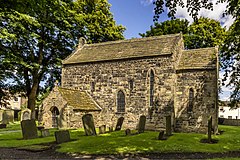Escomb
| Escomb | |
|---|---|
 Escomb parish church | |
 Escomb Escomb shown within County Durham | |
| Population | 3,323 (ward, including Witton Park) (2001 Census)[1] |
| OS grid reference | NZ189300 |
| Unitary authority |
|
| Ceremonial county |
|
| Region |
|
| Country | England |
| Sovereign state | United Kingdom |
| Post town | Bishop Auckland |
| Postcode district | DL14 |
| Dialling code | 01388 |
| Police | Durham |
| Fire | County Durham and Darlington |
| Ambulance | North East |
| EU Parliament | North East England |
| UK Parliament |
|
Escomb is a village on the River Wear about 1 1⁄2 miles (2.4 km) west of Bishop Auckland, County Durham, England. Escomb was a civil parish until 1960, when it and a number of other civil parishes in the area were dissolved.[2]
Contents
1 Parish churches
2 Economic history
3 See also
4 Amenities
5 References
6 Sources
7 External links
Parish churches
Escomb Church was built in the 7th or 8th century AD[3] when the area was part of the Anglian Kingdom of Northumbria, and has been called "England's earliest complete church".[4] The building includes long-and-short quoins[3] characteristic of Anglo-Saxon architecture, and re-used Roman masonry from Binchester Roman Fort.[5]
Until the 19th century Escomb was a dependent chapelry of Bishop Auckland.[6] In 1848 a vicarage was built at the top of the hill and Rev. Henry Atkinson became Escomb's first resident vicar for centuries.[7]
The Anglo-Saxon church seated only 65 people, and in the 19th century Escomb's population outgrew it. In 1863 a new parish church, St John's, was completed next to the vicarage.[5]
Thereafter the old church repeatedly fell into disrepair. It was restored in 1875–80 by RJ Johnson, again in 1927, and again in 1965 by Sir Albert Richardson.[7]
In the 20th century church attendance declined and became too small for St John's. In 1969 the Anglo-Saxon church reverted to being the parish church, and in 1971 St John's was demolished.[7]
Economic history
The George Pit coal mine was sunk in 1837, and an ironworks was opened at Witton Park in 1846.[7]
In 1843 the Bishop Auckland and Weardale Railway was opened between Shildon Junction and Crook to take coal from the area.[8] It passes Escomb but its nearest stop was Etherley railway station, which had been opened by 1847.[8] The line was worked initially by the Stockton and Darlington Railway,[8] through which it became part of the North Eastern Railway in 1863.
WC Stobart & Co's Etherley Colliery was Escomb's major employer from the middle of the 19th century until the seams of its pits became exhausted in the 1920s.[9] The 1851 Census recorded 1,293 inhabitants of Escomb, most of whom worked at the pit.[2]
British Rail closed the Bishop Auckland and Weardale line to passenger traffic in 1965 and to freight traffic in 1993.[8] The Weardale Railway reopened the section past Escomb and through Etherley shortly thereafter.
See also
- Escomb Bridge
Amenities
Escomb has a public house, the Saxon Inn, that was built in the 17th century.[10]
The village has a primary school.[11]
References
^ "Area: Escomb (Ward): Key Figures for 2001 Census: Census Area Statistics". Neighbourhood Statistics. Office for National Statistics. Retrieved 21 April 2011..mw-parser-output cite.citation{font-style:inherit}.mw-parser-output q{quotes:"""""""'""'"}.mw-parser-output code.cs1-code{color:inherit;background:inherit;border:inherit;padding:inherit}.mw-parser-output .cs1-lock-free a{background:url("//upload.wikimedia.org/wikipedia/commons/thumb/6/65/Lock-green.svg/9px-Lock-green.svg.png")no-repeat;background-position:right .1em center}.mw-parser-output .cs1-lock-limited a,.mw-parser-output .cs1-lock-registration a{background:url("//upload.wikimedia.org/wikipedia/commons/thumb/d/d6/Lock-gray-alt-2.svg/9px-Lock-gray-alt-2.svg.png")no-repeat;background-position:right .1em center}.mw-parser-output .cs1-lock-subscription a{background:url("//upload.wikimedia.org/wikipedia/commons/thumb/a/aa/Lock-red-alt-2.svg/9px-Lock-red-alt-2.svg.png")no-repeat;background-position:right .1em center}.mw-parser-output .cs1-subscription,.mw-parser-output .cs1-registration{color:#555}.mw-parser-output .cs1-subscription span,.mw-parser-output .cs1-registration span{border-bottom:1px dotted;cursor:help}.mw-parser-output .cs1-hidden-error{display:none;font-size:100%}.mw-parser-output .cs1-visible-error{font-size:100%}.mw-parser-output .cs1-subscription,.mw-parser-output .cs1-registration,.mw-parser-output .cs1-format{font-size:95%}.mw-parser-output .cs1-kern-left,.mw-parser-output .cs1-kern-wl-left{padding-left:0.2em}.mw-parser-output .cs1-kern-right,.mw-parser-output .cs1-kern-wl-right{padding-right:0.2em}
^ ab Graves, Desmond (2004). "Research Projects: Escomb - a history of George Pit". Durham Miner Project. Retrieved 21 April 2011.
[dead link]
^ ab Blair 1977, p. 158.
^ Jenkins 1999[page needed]
^ ab Blair 1977, p. 157.
^ Lewis 1931, pp. 181–186.
^ abcd Beddow, G (2012). "1863 to 1969 The Missing Years". Escomb Saxon Church. Retrieved 10 April 2018.
^ abcd Catford, Nick (11 March 2011). "Station Name: Etherley". Disused Stations: Closed Railway Stations in the UK. Retrieved 21 April 2011.
^ "Etherley Colliery". Durham Mining Museum. Durham Mining Museum. 30 April 2010. Retrieved 21 April 2011.
^ The Saxon Inn Archived 6 December 2013 at the Wayback Machine.
^ Escomb Primary School
Sources
Blair, Peter Hunter (1977) [1956]. An Introduction to Anglo-Saxon England (Second ed.). Cambridge & London: Cambridge University Press. pp. 157–158. ISBN 0-521-29219-0.
Jenkins, Simon (1999). England's Thousand Best Churches. London: Penguin Books. pp. 170–172. ISBN 978-0-14-103930-5.
Lewis, Samuel, ed. (1931) [1848]. A Topographical Dictionary of England (Seventh ed.). London: Samuel Lewis. pp. 181–186.
External links
![]() Media related to Escomb at Wikimedia Commons
Media related to Escomb at Wikimedia Commons

Comments
Post a Comment